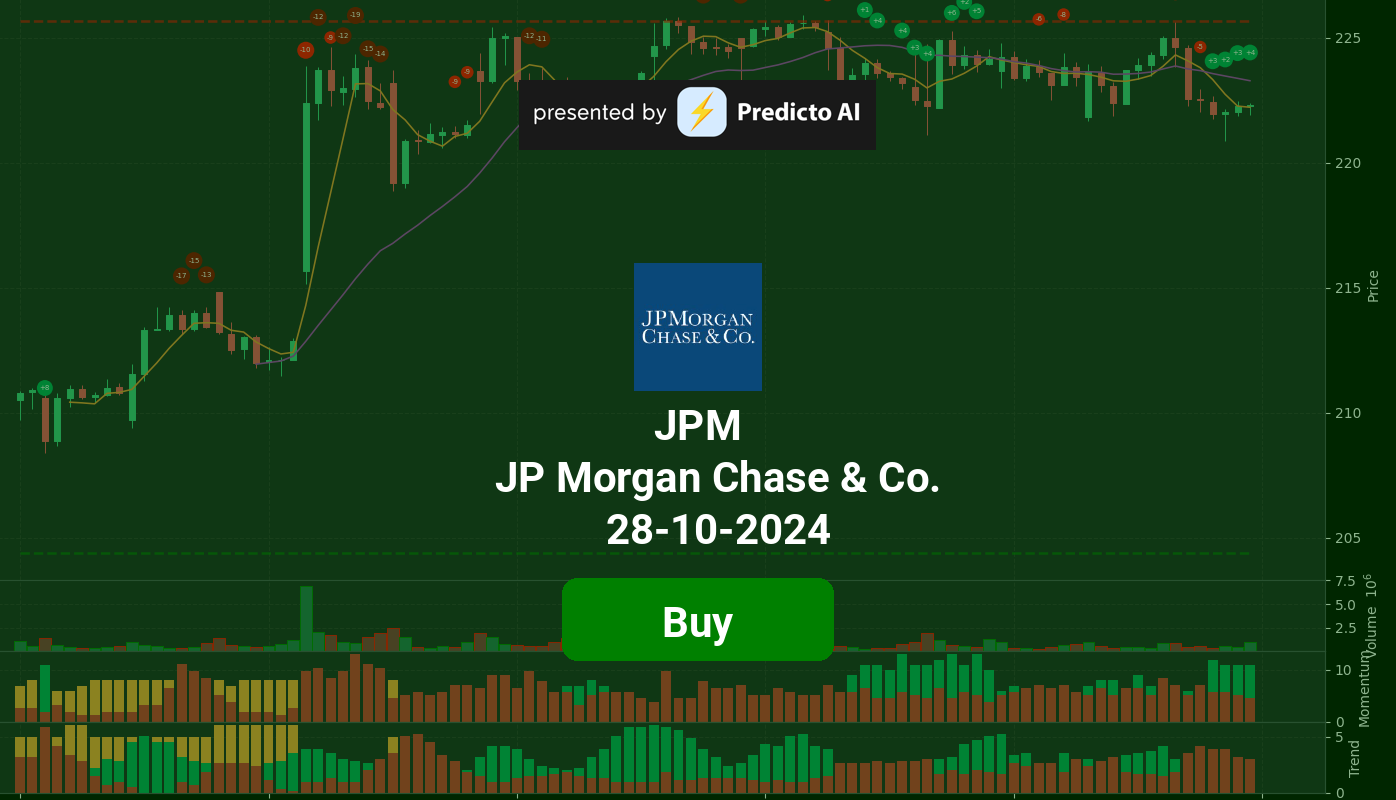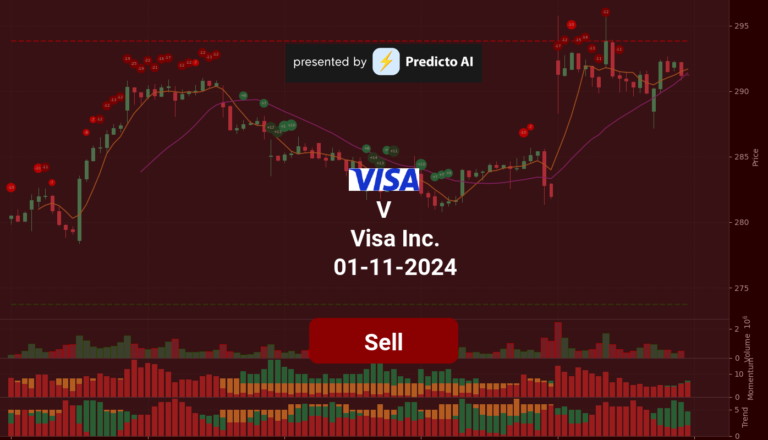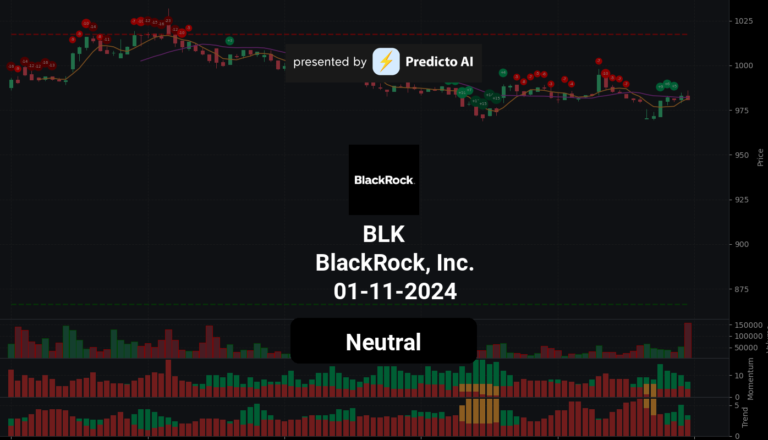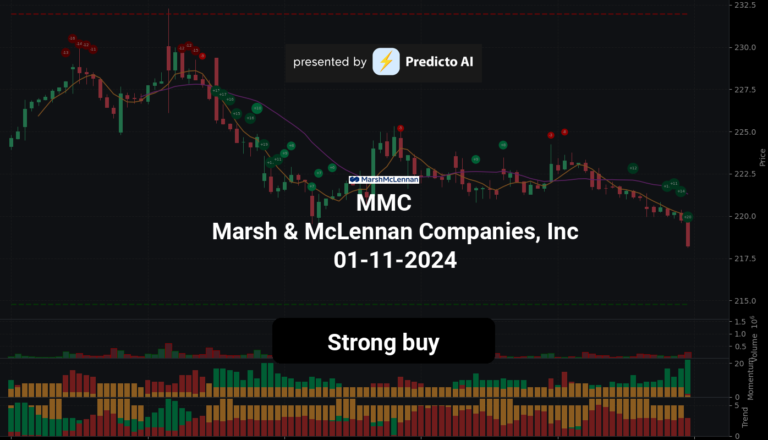JPMorgan Chase & Co. (JPM) Stock Analysis: A Mixed Bag of Signals
🔵 Recommendation: JPM is currently rated as a buy, reflecting a blend of optimism and caution in the market.
📈 Key Highlights:
Financial Health: Strong net income of $18.15 billion and a year-over-year increase in profitability.
Operational Efficiency: Exceptional operating margin of 100.00% and a net profit margin of 36.26%.
Growth Potential: Revenue growth of 19.45% year-over-year indicates robust growth prospects.
⚠️ Caution Flags:
Debt Concerns: A debt-to-equity ratio of 1.81 raises financial risk concerns.
Valuation Metrics: A high price-to-sales ratio of 3.94 suggests potential overvaluation compared to peers.
Insider Transactions: Low insider ownership at 0.45% and mixed insider transactions could indicate volatility.
As we delve deeper into the analysis, we will explore the price trends, momentum indicators, financial health, valuation metrics, and the broader economic context affecting JPMorgan Chase & Co. Join us as we break down the complexities of this financial giant and what it means for investors moving forward. 👇
JPM Price Analysis
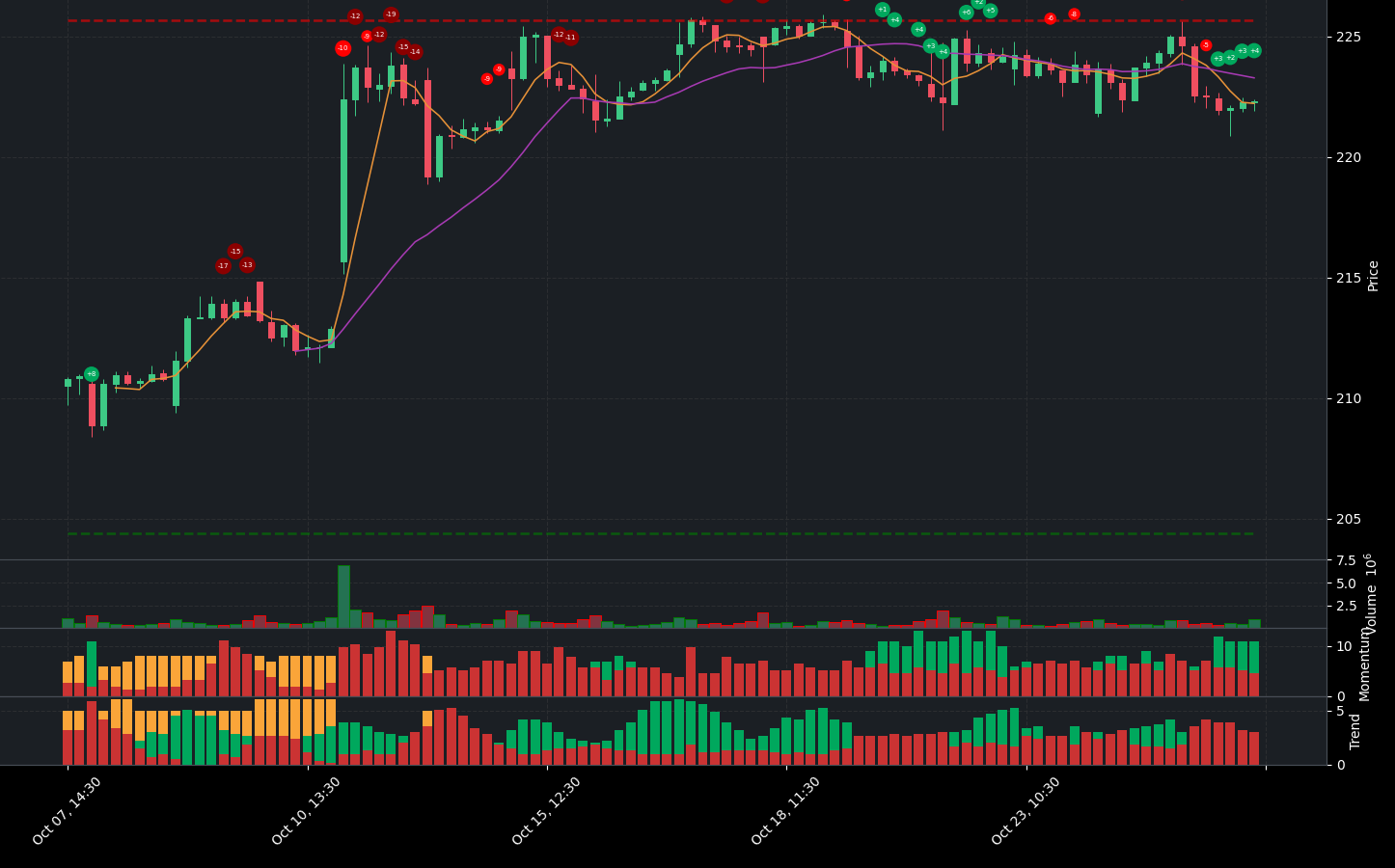
| Positive Momentum Signals | Negative Momentum Signals | Hold Momentum Signals |
|---|---|---|
|
|
|
| Positive Trend Signals | Negative Trend Signals | Hold Trend Signals |
|---|---|---|
|
|
|
JPMorgan Chase & Co. (JPM) presents a complex investment landscape characterized by both positive and negative indicators. Currently, the stock is rated as a buy, reflecting some optimism in the market.
On the positive side, momentum indicators suggest a potential rebound, with the StochRSI and WaveTrend both indicating oversold conditions, which could signal a potential bottom. Additionally, the On-Balance Volume (OBV) is increasing, supported by high volume, indicating strong buying interest. The price is also above the 200-day EMA, reinforcing a bullish trend, and the MACD has shown a positive histogram crossover, further supporting the bullish sentiment.
However, caution is warranted due to several negative momentum and trend indicators. The WaveTrend shows a bearish divergence, suggesting a potential reversal, and the stock is positioned closer to resistance levels. Furthermore, the price is currently below the 50-day EMA and the middle band, indicating a bearish trend that is strengthening. The Supertrend also indicates a bearish position, as the price remains below this indicator.
In summary, while JPMorgan Chase & Co. shows some promising signs with increasing volume and bullish long-term trends, the presence of bearish indicators and resistance levels suggests that investors should proceed with caution. A buy recommendation is appropriate, but investors should remain vigilant for signs of reversal or further bearish momentum.
JPM Fundamental Analysis
JPMorgan Chase (JPM) presents a compelling investment opportunity, characterized by strong financial health and growth potential, despite some concerns regarding its debt levels and valuation metrics.
The company’s recent performance showcases impressive profitability, with a net income of $18.15 billion for the most recent period, reflecting a significant year-over-year increase. This growth is further supported by an operating margin of 100.00%, indicating exceptional operational efficiency and cost control. Additionally, a net profit margin of 36.26% highlights JPM’s strong ability to generate profits after accounting for all expenses.
However, there are some red flags to consider. The debt-to-equity ratio stands at 1.81, raising concerns about financial risk due to a higher reliance on debt financing. Furthermore, the cash to total assets ratio of 0.14 suggests limited financial flexibility, which could make the company vulnerable to economic shocks.
In terms of valuation, JPM’s forward P/E ratio of 13.29 indicates potential undervaluation, suggesting that the stock may be a good buy at current levels. Conversely, the price-to-sales ratio of 3.94 is relatively high, which could indicate overvaluation compared to its peers.
Growth metrics are promising, with a revenue growth of 19.45% year-over-year, signaling strong growth potential that may positively impact the stock price. The company’s profit margins of 33.73% further demonstrate its ability to generate profits efficiently. However, the earnings growth of only 0.90% is modest, suggesting that while the company is profitable, growth may be slowing.
From a shareholder perspective, JPM has positive net cash from financing activities amounting to $146.34 billion, indicating that the company is raising capital for growth or debt reduction. The stock repurchases of $12.34 billion signal management’s confidence in the company’s future prospects, although the average ordinary shares outstanding at 2.88 billion raises potential dilution concerns if shares are issued.
On the income statement, total revenue of $50.06 billion reflects strong sales performance, while the operating and net profit margins reinforce the company’s efficient operations and profitability.
The balance sheet reveals an average total debt of $426.68 billion, which raises concerns about financial leverage and risk profile. However, an average tangible book value of $235.30 billion indicates a solid net worth after liabilities. The average treasury shares of 1.23 billion could suggest significant buyback activity, which may impact cash reserves.
In terms of cash flow, the positive net cash from financing activities indicates healthy capital-raising efforts, although the absence of average free cash flow data suggests a reliance on external funding.
Overall, JPMorgan Chase demonstrates strong financial health and growth potential, making it a strong buy at current levels. Investors should weigh the operational efficiency and profitability against the concerns regarding debt levels and valuation metrics before making investment decisions.
Financial Health
🟢 Net Income for the most recent period was $18.15 billion, indicating strong profitability.
🟢 Year-over-year net income increased, which is a positive sign for future performance.
🟢 Operating Margin of 100.00% suggests exceptional operational efficiency and cost control.
🟢 Net Profit Margin of 36.26% reflects the company’s strong ability to generate profits after all expenses.
🔴 Debt-to-Equity Ratio of 1.81 raises concerns about financial risk, indicating a higher reliance on debt financing.
🟢 Current Ratio of 4.45 indicates a healthy liquidity position, suggesting the company can comfortably cover its short-term liabilities.
🔴 Cash to Total Assets Ratio of 0.14 suggests limited financial flexibility and potential vulnerability to economic shocks.
Valuation
🟢 Forward P/E ratio of 13.29 indicates potential undervaluation, suggesting the stock may be a good buy at current levels.
🔴 Price-to-Sales Ratio of 3.94 is relatively high, which could indicate overvaluation compared to peers.
Growth and Profitability
🟢 Revenue Growth of 19.45% year-over-year indicates strong growth potential, which may positively impact stock price.
🟢 Profit Margins of 33.73% demonstrate the company’s ability to generate profits efficiently.
🔴 Earnings Growth of 0.90% is modest, suggesting that while the company is profitable, growth may be slowing.
Shareholder Information
🟢 Positive net cash from financing activities of $146.34 billion indicates the company is raising capital for growth or debt reduction.
🟢 Stock repurchases of $12.34 billion can signal management’s confidence in the company’s future prospects.
🔴 Average Ordinary Shares Outstanding at 2.88 billion indicates potential dilution concerns if shares are issued.
Income Statement
🟢 Total Revenue for the most recent period was $50.06 billion, showing strong sales performance.
🟢 Operating Margin of 100.00% suggests efficient operations, while the Net Profit Margin of 36.26% reflects strong profitability.
Balance Sheet
🔴 Average Total Debt of $426.68 billion raises concerns about the company’s financial leverage and risk profile.
🟢 Average Tangible Book Value of $235.30 billion indicates a solid net worth after liabilities.
🔴 Average Treasury Shares of 1.23 billion could indicate significant buyback activity, which may impact cash reserves.
Cashflow
🟢 Positive net cash from financing activities indicates healthy capital raising efforts.
🔴 Average Free Cash Flow is not provided, but the high net cash from financing suggests reliance on external funding.
Overall, JPMorgan Chase shows strong financial health and growth potential, despite some concerns regarding its debt levels and valuation metrics. The company’s operational efficiency and profitability are significant positives, making it a strong buy at current levels.
JPM News Analysis
JPMorgan Chase & Co. (JPM) is experiencing a mixed sentiment based on recent news. While there are positive developments regarding dividend-focused investments, there are also concerns related to Jamie Dimon’s political stance and potential implications for the bank’s public image. Investors should weigh these factors carefully.
Summary of JPM news indicates a blend of positive and negative sentiments surrounding JPMorgan Chase & Co. (JPM). The focus on high-dividend ETFs suggests a strong interest in income-generating investments, which could benefit JPM. However, the political silence of CEO Jamie Dimon raises questions about the bank’s public relations strategy and potential impacts on investor confidence.
🟢 The Motley Fool highlights the appeal of high-dividend ETFs, which could attract investors looking for passive income, indirectly benefiting JPM as a major player in the financial sector.
🟢 The mention of ETFs heavily invested in Nvidia with high yields indicates a growing interest in tech-related investments, which could positively influence JPM’s market positioning.
🔴 Jamie Dimon’s reluctance to endorse any political candidate may create uncertainty among investors regarding the bank’s future direction and public perception.
🔴 The speculation around Dimon’s potential political involvement could distract from the bank’s core business operations and affect investor sentiment.
🔴 Reports of Dimon supporting Kamala Harris behind closed doors may lead to mixed reactions from investors, depending on their political views.
🟢 The dividend investor’s portfolio details suggest that JPM remains a strong contender for income-focused investors, which could stabilize its stock performance in the short term.
JPM Holders Analysis
The financial health of JPMorgan Chase & Co. indicates a generally positive outlook, but some caution is warranted due to mixed signals from insider transactions and the low insider ownership.
🟢 JPM has a **high institutional ownership** at 73.76%, which reflects strong interest from large investors. This level of institutional backing typically suggests confidence in the company’s future performance.
🟡 The **insider ownership is very low at 0.45%**, indicating a potential lack of confidence from management or a high degree of external control. This could lead to volatility if institutional investors decide to sell.
🟢 The number of institutional holders is substantial at **5093**, which indicates a diversified ownership structure and widespread interest in the stock.
🟡 Recent insider transactions show a **mix of purchases and sales**, with a slight inclination towards selling. This could suggest that insiders are taking profits or reallocating their investments, which may not be a strong bullish signal.
🔴 The **insider purchases over the last six months are minimal**, with only 18,170 shares bought compared to 85,589 shares sold. This disparity raises concerns about the level of confidence insiders have in the company’s future.
JPM Analyst Ratings
The analyst ratings for JPM have shown a strong positive trend, with a significant number of analysts recommending either a buy or strong buy. In the last month, there were 5 strong buy ratings, 12 buy ratings, and only 8 hold ratings, indicating a bullish sentiment among analysts. The absence of sell or strong sell ratings further reinforces this positive outlook. 🟢
In the past month, the upgrades from firms such as Oppenheimer, Barclays, and RBC Capital, all maintaining an outperform rating, suggest that analysts are confident in JPM’s performance. The overall sentiment is supported by the bank’s solid fundamentals and market position.
Looking ahead, it is likely that JPM will see continued positive momentum in the next month, with a forecasted price increase of approximately 5-7%. This is based on the current analyst recommendations and the historical performance trends of the stock. The high confidence level indicates a strong belief in this forecast.
JPM Economic Analysis
Based on the US economic and market data:
🟢 The **unemployment rate** has increased slightly to **4.3%**, but this is still relatively low, indicating a stable labor market that supports consumer spending.
🟡 **Retail sales** have shown an increase to **627,510**, suggesting that consumer demand remains robust, which is positive for JPMorgan’s banking services.
🔴 The **CPI** remains high at **314.540**, indicating persistent inflation, which could lead to further interest rate hikes by the Federal Reserve, potentially impacting bank margins negatively.
🟢 The **GDP** growth rate is stable at **5737.189**, reflecting a resilient economy that can support JPMorgan’s diverse financial services.
🟡 The **monthly treasury yield** is at **4.25%**, which is relatively high but could stabilize in the coming month, providing a mixed outlook for interest-sensitive sectors.
Overall, while there are some concerns regarding inflation and interest rates, the underlying economic indicators suggest that JPMorgan is well-positioned to benefit from stable consumer demand and a solid banking environment. The stock price is currently at **222.31**, with a target mean price of **227.03**, indicating potential upside in the near term.
Disclaimer
Investors may consider the AI predictions and news summaries as one factor in their investment decisions alongside their own research and risk tolerance.

